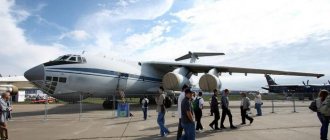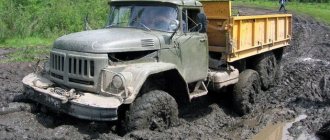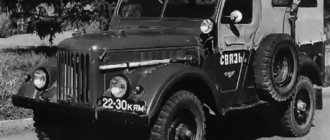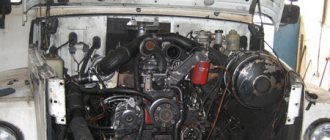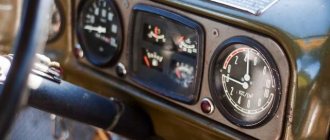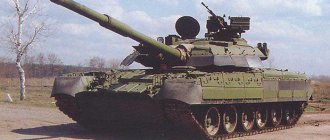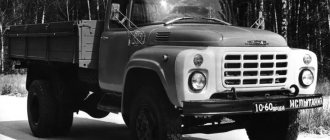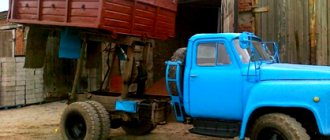ZIL 130 is a Soviet truck model equipped with a 5-speed gearbox. Production began in 1962 and continued after the collapse of the Soviet Union in Russia until 2014. Initially, the truck was equipped with a 150 hp gasoline engine, later models with a diesel engine and a gas cylinder with a capacity of 140 and 120 hp appeared on the market. Fuel consumption on trucks depends on the type of engine, operating conditions, and condition of the vehicle.
History of creation
Work on creating a promising truck designed to replace the ZiS-150 began at the I.V. Automobile Plant. Stalin in 1953. The vehicle project was designated ZiS-125 or 150M. The work was supervised by A.M. Krieger and G.A. Festa. The first prototype with a carrying capacity of 4 tons was assembled by 1956 under the designation ZIL-130.
The fine-tuning of the vehicle and engine took more than a year, and in 1957 the technical specifications were adjusted - the ZIL-130 was planned to be used not only as a truck, but also as a tractor. Modified vehicles with a new power unit entered testing in 1959.
The development of the final design of the truck cabin, which was created by the leading artist of the ZiL plant T.P., also dates back to this time. Kiseleva.
In the outline of the cabin one can feel the influence of the American truck industry of the 50s of the last century.
It was the panoramic glass used on the ZIL-130, the design and shape of the wings, as well as the general solution of the radiator grille that were characteristic of trucks from the USA.
Small-scale production began in the fall of 1962, and mass production only in the fall of 1964, when the new truck completely replaced the ZIL-164A from the assembly line. The production of trucks was growing at an increasing pace, and in the 70s the plant annually produced up to 200 thousand vehicles based on the ZIL-130.
Since the beginning of 1986, the ZIL plant switched to a new model designation standard and the 130th, having undergone another modernization, began to be designated ZIL-431410. The car remained on the assembly line of the Moscow plant until the end of 1994. The automobile plant in Novouralsk produced trucks under the AMUR brand until 2010.
Service
In this section it is worth talking about changing the oil. This process is very easy to do.
To do this you should:
- Unscrew the drain plug;
- Unscrew the oil filter plug and drain the oil;
- Unscrew the nut and remove the oil filter cover;
- Remove the metal and rubber seal;
- Remove the oil filter and remove the rod;
- The filter should be changed in the reverse order;
- Fill in the oil and let the power unit run for 5 minutes;
- Check the oil level using the dipstick and top up if necessary.
Description of design
The ZIL-130 truck is a hood-type design with rear drive wheels and a load capacity of 5.5 tons (early versions) to 6.0 tons (latest models).
The basis of the machine is a riveted frame made of channel profile spars and transverse reinforcements.
Dependent axle suspensions on leaf springs. The front axle is equipped with telescopic shock absorbers, the rear axle is equipped with springs.
Engine
The first experimental ZIL-130 trucks were equipped with a 6-cylinder overhead valve gasoline engine model E130. The motor had a V-shape with a right angle of camber of the blocks. With a working volume of 5.2 liters, power up to 135 hp was expected, however, during testing the unit was unable to develop more than 121 hp.
Power 130 hp managed to get it on the modernized version 1E130. At the same time, work was underway to refine the in-line lower-valve engine ZIL-120, from which it was possible to squeeze out the same 130 forces.
Changes in the technical specifications regarding increasing the traction force of the truck entailed the need to use motors with a power of at least 150 hp. This requirement put an end to further work on the “sixes”, and the designers switched to developing a V-shaped 8-cylinder unit of the 3E130 model with a displacement of 6.0 liters.
Prototypes appeared in 1958 and developed power up to 151 hp.
After modifications, the engines went into mass production in 1959 under the designation ZIL-130 and had 148 hp. (first years of graduation).
The engine underwent numerous changes and was used until the ZIL-130 truck was discontinued from production. A-76 gasoline (including leaded) was used as fuel. The average fuel consumption on the cargo ZIL-130 was 28-30 l/100 km.
The gas-cylinder version of the ZIL-138 (liquefied gas) had an increased compression ratio, due to which it developed 150 hp. The version for running on compressed gas was designated 138A and developed 120 horsepower.
Since 1974, the chassis for the 130K dump truck and the ZIL-130AN truck were produced, equipped with an in-line 6-cylinder lower valve 110-horsepower engine, created on the basis of the 157th model. The engine had a number of modifications related to the specific design of the truck.
Exported ZIL-130 vehicles were equipped with a 140-horsepower Perkins 6.345 diesel engine or a 125-horsepower Valmet 411BS and a 137-horsepower Leyland.
The engines had an in-line 4- or 6-cylinder design.
Hydraulics
There is no hydraulic system on the ZIL-130 flatbed truck. The hydraulic cylinder drive is used to unload the body on dump trucks. The pressure in the line is created by an additional gear pump located on the power take-off.
Transmission
The ZIL-130 truck received a box similar in design to that used on the ZIS-150. The box has five forward speeds, with synchronizers in the four highest gears. There is no overdrive, fifth speed is direct. The clutch is dry type, has one disc and is equipped with a mechanical drive.
To complete tractors and dump trucks, it was planned to equip them with a two-speed rear axle, with the ability to change gears with a splined clutch. The unit could not be brought to the stage of mass production. All variants of the ZIL-130 were equipped with a single-speed, two-stage rear axle.
Steering
The steering mechanism of the truck is built on the principle of a screw and nut and is equipped with a hydraulic booster driven by a pump mounted on the engine. The steering column was rigidly installed in the cabin.
The steering shaft was connected to the gearbox by a cardan shaft. Versions for countries with hot climates were equipped with a radiator to cool the working fluid. The steering wheel is plastic, equipped with three spokes.
Electrical system
The truck is equipped with a 12-volt DC system with the negative terminal connected to the body. A generator with a power of 225 to 1260 W (depending on the year of manufacture and model) was mounted on the engine.
The battery is installed in a niche under the cab.
Military versions were equipped with waterproof and sealed equipment.
Brake system
The service brakes of the ZIL-130 truck are drum type, with a pneumatic drive. The pneumatic system included a 2-cylinder compressor and a system of two receivers with a capacity of 20 liters each. The compressor is driven by a belt from the crankshaft pulley and is connected to the general engine lubrication and cooling system.
The parking brake of early cars was controlled by a lever in the cab and acted on a drum-type mechanism located on the output shaft of the transmission. On the rear cross member of the frame next to the towing device there is an outlet for connecting the air brakes of the trailer.
On ZIL-130-80 vehicles, separate drives for the front and rear axles with an additional brake force regulator began to be used.
The system began to use four receivers.
To drive the parking brake, a separate pneumatic system was used, which at the same time served as an emergency system. The parking brake was activated by a crane from the cab. The hand brake drum was removed from the gearbox shaft.
Body and cabin
The cabin is two-door, three-seater, all-metal, equipped with a heating system, windshield cleaning, roll-down door windows and rotary windows. Early cars had two roof vents, which were gradually abandoned. A characteristic external feature of early cars (before 1974) is the absence of turn signals on the wings.
On civilian vehicles, a one-piece windshield was used; on vehicles for the army, a version of two halves (unified with the ZIL-131) could be installed.
Two types of radiator lining were used on the cabs:
- Early type (before November 1978), with overhead headlights and large radiator vents;
- Late version, with lower-mounted headlights and small air duct slots.
The truck's side platform is made of wood with metal reinforcing frames. The standard platform had two sides on the sides, the extended one on the ZIL-130GU had three. A tool box was installed under the platform floor.
Main modifications
ZIL-130 is the first civilian dump truck of the brand, produced back in the USSR. Initially, the equipment was created for military needs. The cars were then adapted for civilian use. ZIL-130 or simply “Kolkhoznik” has become one of the most popular domestic medium-tonnage vehicles. Today, the car maintains its position in the market due to its low cost and quick payback.
Increase in norm
There are circumstances under which the average fuel consumption on a ZIL increases for every hundred kilometers.
Such a circumstance may be the time of year.
And now let’s talk about how costs are increasing
:
- in the southern regions the change is insignificant - only about 5%;
- in the temperate climate zone there is an increase in fuel consumption by 10%;
- a little further north the flow rate will already increase to 15%;
- in the Far North, in Siberia - up to 20% increase.
Having this data at hand, it is easy to calculate what gasoline consumption is on a ZIL 130 in winter. For example, if you do the math (taking the norm as 31.5 cubic meters), then a car will spend at least 34.5 cubic meters of gasoline for a kilometer distance in a temperate climate in winter.
Linear fuel consumption also increases with increasing mileage - we wear out the engine. Here the statistics are as follows
:
- new car – mileage up to 1000 km – increase by 5%;
- for every new thousand km driven – an increase of 3%.
Fuel consumption varies depending on the terrain you drive on. It's no secret that the fuel consumption of the ZIL 130 on the highway is less than normal, and is usually 28-32 liters for every 100 km
. On the highway you have to stop less, the road is better there, you can gain stable speed and not overwork the engine. Cars of this brand most often drive along the highway, because trucks of this type are designed to move cargo over long distances.
As drivers say, fuel consumption rates for the ZIL 130 in the city are increasing significantly. The dump truck has to constantly maneuver, stand at traffic lights, pedestrian crossings, and maintain a speed that is not as high as it could develop on the highway, which is why gasoline consumption increases. In urban conditions it is 38-42 liters per 100 kilometers.
Technical characteristics in comparison
| Parameter | ZIL-164 | ZIL-130 | KAZ-608 (tractor tractor) |
| Load capacity, kg | 4000 | 6000 (14400 in the tractor version) | 15500 |
| engine's type | Petrol, 6-cyl. | Petrol, 8-cyl. | Petrol, 8-cyl. |
| Power, hp | 97 | 150 | 150 |
| Curb weight, kg | 4100 | 4300 | 4000 |
| Maximum speed, km/h | 75 | 85 | 80 |
| Fuel consumption l/100km | 27 | 28…32 | 41…46 |
As can be seen from the technical characteristics, the ZIL-130 looked decent at the level of its competitors.
Fuel consumption of other Soviet trucks
You should always remember that fuel consumption depends on the operating conditions of the vehicle, its technical condition and the driver’s skills. Therefore, the easiest way to navigate is by reference flow.
| Model | Consumption, l/100 km |
| GAZ-53-03 | 21 |
| UAZ-451D | 12 |
| MAZ-200 | 32 |
| MAZ-500 | 22 |
| Ural-377 | 50 |
| KrAZ-219B | 55 |
| KrAZ-222B | 60 |
| GAZ-66 | 24 |
| ZIL-157K | 42 |
Application
ZIL-130 trucks and chassis were widely used in the national economy. Based on the machine, buses (Tajikistan brand), dump trucks, tanks, delivery and technical vans were produced. A large number of ZIL-130 chassis were used to create fire fighting vehicles - tank trucks, hose trucks, pumping stations.
The ZIL-130E modification, which had a number of electrical equipment components from the 131st model, was intended for deliveries to the Soviet Army. The equipment included additional canisters with a capacity of 10 and 20 liters, a set of entrenching tools, and blackout caps for the headlights.
On request, sides of increased height were installed with the possibility of installing arches for the awning. A second fuel tank capable of holding 170 liters of gasoline could be installed on the right side member.
What can be concluded?
In 1986, ZIL-4331 was put into production. It was ahead of popular transport in many respects. In the early 90s, the deteriorating economic situation forced owners to abandon the use of the 130 due to high costs of fuel and repairs.
If in our time a person buys such a car for constant use, he has to do some rebuilding. In particular, the use of ZIL-130 diesel allows you to save money on gasoline costs.
Most often, a dump truck is purchased to implement creative ideas. Truck tuning is common in the post-Soviet space. You can buy a car for 30-50 thousand rubles, but then you will have to spend money on repairs. The price of copies in good condition can reach up to 400 thousand rubles.
Modernization
Over the years of production, the ZIL-130 vehicle underwent three major upgrades, after which the designation of the base model changed:
- 1966 - the designation changed to ZIL-130-66;
- 1976 - on ZIL-130-76;
- 1984 - on the ZIL-130-80 (according to the NIINavtoprom reference books, the model was introduced in 1981).
During the modernization of 1966, it was possible to increase the service life of the vehicle to 200 thousand km (before the first major overhaul), and increase the engine power to 150 horsepower. A number of improvements have been introduced into the design aimed at improving the vehicle's performance.
The 1976 version had a service life of 300 thousand km and a payload capacity increased to 6 tons. Model 130-80 trucks were equipped with an improved braking system, an economical carburetor and a number of other improvements.
Features and operation
The basic modification of two-axle vehicles with a 4X2 wheel arrangement is the onboard tractor ZIL 431410. The all-metal cabin used a single panoramic window, equipped with a washer and two electric windshield wipers. Comfortable driving is ensured by a driver's seat adjustable in three positions and an installed power steering. To transport tools used for routine repairs, a special metal box was installed on the left, in the rear of the car under the platform. There is a socket attached to the frame at the rear of the car for connecting trailer lighting. Unlike previous versions of the vehicle, the ZIL 431410 was equipped with a new, specially designed and more informative instrument panel. One of the features of the car is the use of side sides of the body, consisting of two parts, which is quite convenient for various types of loading and unloading operations.
Interesting Facts
At the ZIL branch in Chita, the northern version of the ZIL-130S was assembled, which was equipped with a winch driven by a gearbox. The machine was intended for operation at temperatures down to -60°C. The cars were painted in bright orange or red, as well as army khaki.
Since 1973, ZIL-130 trucks and chassis had the USSR State Quality Mark, which confirmed the high performance of the products.
Today, ZIL-130 trucks are outdated and are gradually being written off due to deterioration of the structure and significant fuel consumption.
The remaining units are converted by replacing the gasoline engine with a diesel unit (usually a product of the Minsk Motor Plant D-245). Early production trucks are very rare and have become collector's items.
ZIL-130 photo
Read more:
Chevrolet Camaro Z28
Like Velar, but cheaper, the British presented the Range Rover Evoque
All-terrain vehicle Burlak: ready to conquer the North Pole!
Porsche 917
Arash AF10
Crankshaft
Dependent; front on two semi-elliptic springs with rear sliding ends and shock absorbers; rear balancing on two semi-elliptic springs with six reaction rods, the ends of the springs are sliding. The car was equipped with a synchronized gearbox with 5 steps and hydraulic power steering, and some ZIL-130s were equipped with engine preheating.
Engine. : Electrical system
Both surfaces must be perfectly flat, since when assembling and installing gaskets, a leak may form, which will entail repeated disassembly and repair. Every experienced driver knows that every extra kilogram significantly increases the amount of liquid flammable substance required for movement.
| Total weight | 650 kg |
| Engine oil displacement | 8.74 l |
| dimensions | 700*450 mm |
| Number of bars | 4 |
| Number of cylindrical elements | 8 |
| Compression ratio of the working mixture | 18,5 |
| Power unit power | 185 l. With. |
| Maximum engine speed | 2800 rpm |
| Rated torque | 490 Nm |
| Cooling system tank volume | 26.5 l |
| Piston stroke | 110 mm |
| Diameter of cylindrical elements | 115 mm |
| Average fuel consumption | 27 l per 100 km |
| International environmental standard | Euro-3 |
| Cylinder arrangement | V-shaped |
Instructions
Oil leakage
through worn engine gaskets, camshaft seals and other leaks and seals. Leaks can be detected with the naked eye. To eliminate this problem, replace worn gaskets and seals with new parts. Tighten all the bolts on the engine involved in crimping the gaskets. When installing a new gasket, use a sealant with the appropriate operating temperature.
Worn valve stem seals. A characteristic sign of a malfunction is small puffs of bluish smoke coming out of the exhaust pipe with a sharp increase in engine speed. To resolve this problem, remove the engine valve cover. Remove the camshaft, then the rocker arms. Loosen and remove the valve springs, replace the caps. Reassemble everything strictly in the reverse order of disassembly. Be extremely careful when disassembling and reassembling to avoid dropping the valve into the cylinder.
You may be interested in: How to wind a UAZ speedometer
The most serious reason is wear of the oil scraper rings. With this malfunction, smoke constantly comes out of the exhaust pipe, and it looks not like a cloud, but like a trail behind a moving car. Disassemble the engine and remove the pistons and rings. Replace worn rings. Using special tools, assemble the pistons with the cylinder block and assemble the engine. It is advisable to replace the piston rings together with a major overhaul of the engine, as this indicates severe wear.
New owner – Cooling system
To solve this problem, install electric fans that will rotate at a frequency that does not exceed 3500 rpm, which is quite low. To prevent the ends of the piston pin from damaging the surface of the cylinder, movement along the axis is limited by steel hoops fixed in the displacer bosses.
| Parameter | Meaning |
| Diameter of main journals, mm | 74,48 – 74,50 |
| Diameter of connecting rod journals, mm | 65,48 – 65,50 |
Disassembly. Electrical system
| Motor oil zil 131 According to the first version of the origin of this phenomenon, at USSR enterprises there was an abundance of paint of only a few colors, including blue, and even the famous dark green shade of paint for military equipment was obtained by mixing yellow and blue paints. It is necessary to ensure that the wires are connected correctly to the terminals of the additional resistor; a wire from the starter must be connected to terminal VK; - to terminal VK-B from the ignition switch; and to terminal K from the terminal of the transistor switch. |
- Product length, (mm) – 185.00:
- Head hole cross-sectional diameter (top/bottom, mm) – 27.5/69.5
Goodbye, excellent advanced engine • In the early 70s, the plant began developing the promising ZIL-169 truck.
ZIL 432930, 432932, 497442 Repair manual... Lubrication system
| The plant covered the history of unique cars and where they disappeared. children zil today The service life of all main components is an order of magnitude higher than indicated, we can say that the car is practically indestructible, plus instead of the standard 5-6 tons, you can safely load up to 7-9 tons. Body volume, vehicle weight, load capacity and other indicators significantly depend on the specific modification, and therefore should be read separately. |
| History of the ZIL-130: everything about one of the most popular trucks in the USSR - Zen - ATI, Center: Freight Transportation System In 1980, the Cuban state-owned enterprise Martires de Giron launched a campaign to re-motorize this truck, replacing the original engine with its own diesel engine. The cardan transmission consists of four cardan shafts: gearbox, transfer case, front axle transfer case, middle axle transfer case, middle axle, rear axle. |
- a vehicle for regular transportation of people and goods (16 + 8 seats);
- saddle car of traction type;
- a model resistant to transporting large loads in desert conditions;
- special purpose transport (oil tankers, fuel tankers, fire tankers, etc.).
Design Features • The vehicle has drum brakes on all wheels.
